Apple Company Supply Chain Report 2022
VerifiedAdded on 2022/09/18
|16
|3216
|67
AI Summary
Contribute Materials
Your contribution can guide someone’s learning journey. Share your
documents today.
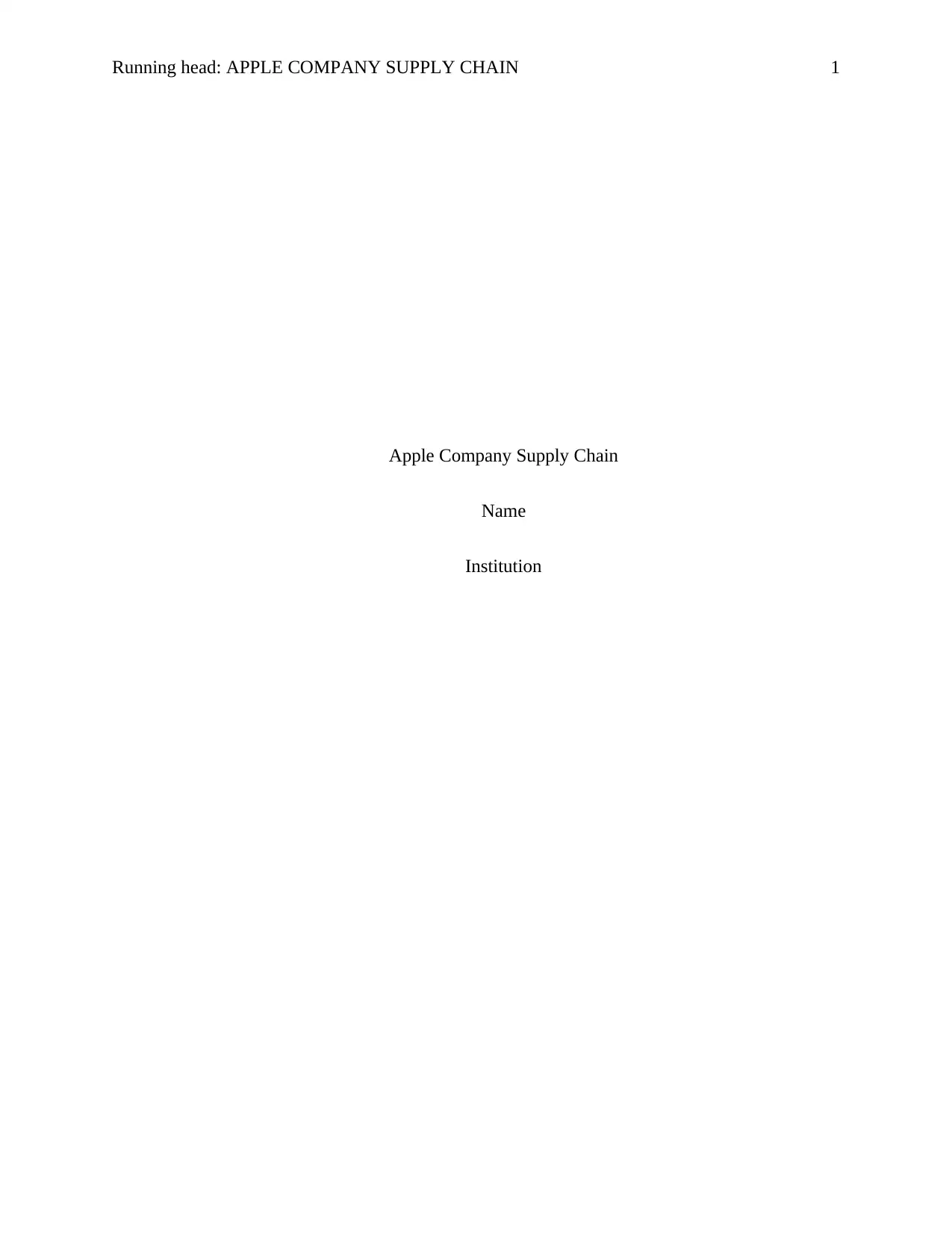
Running head: APPLE COMPANY SUPPLY CHAIN 1
Apple Company Supply Chain
Name
Institution
Apple Company Supply Chain
Name
Institution
Secure Best Marks with AI Grader
Need help grading? Try our AI Grader for instant feedback on your assignments.
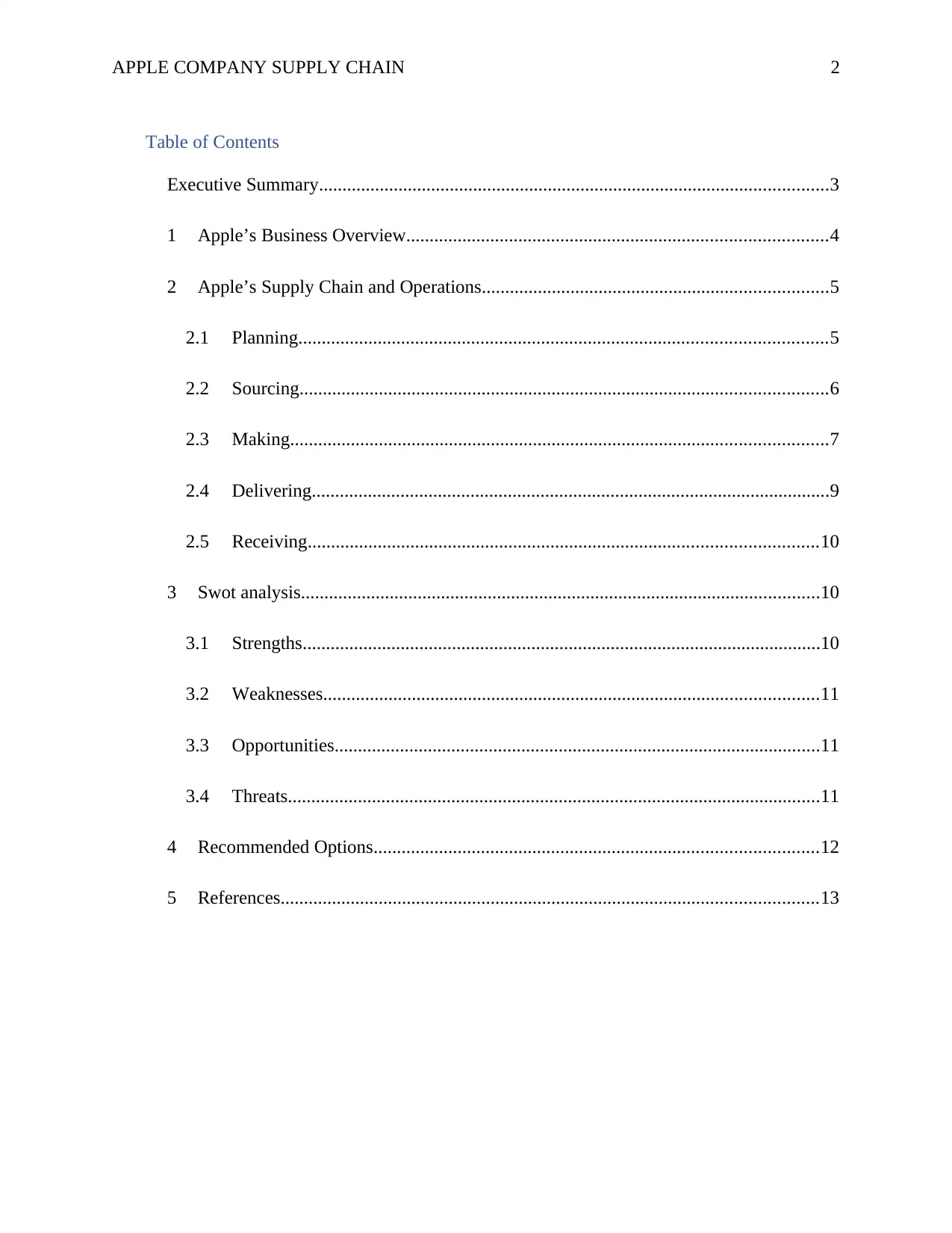
APPLE COMPANY SUPPLY CHAIN 2
Table of Contents
Executive Summary.............................................................................................................3
1 Apple’s Business Overview..........................................................................................4
2 Apple’s Supply Chain and Operations..........................................................................5
2.1 Planning.................................................................................................................5
2.2 Sourcing.................................................................................................................6
2.3 Making...................................................................................................................7
2.4 Delivering...............................................................................................................9
2.5 Receiving.............................................................................................................10
3 Swot analysis...............................................................................................................10
3.1 Strengths...............................................................................................................10
3.2 Weaknesses..........................................................................................................11
3.3 Opportunities........................................................................................................11
3.4 Threats..................................................................................................................11
4 Recommended Options...............................................................................................12
5 References...................................................................................................................13
Table of Contents
Executive Summary.............................................................................................................3
1 Apple’s Business Overview..........................................................................................4
2 Apple’s Supply Chain and Operations..........................................................................5
2.1 Planning.................................................................................................................5
2.2 Sourcing.................................................................................................................6
2.3 Making...................................................................................................................7
2.4 Delivering...............................................................................................................9
2.5 Receiving.............................................................................................................10
3 Swot analysis...............................................................................................................10
3.1 Strengths...............................................................................................................10
3.2 Weaknesses..........................................................................................................11
3.3 Opportunities........................................................................................................11
3.4 Threats..................................................................................................................11
4 Recommended Options...............................................................................................12
5 References...................................................................................................................13
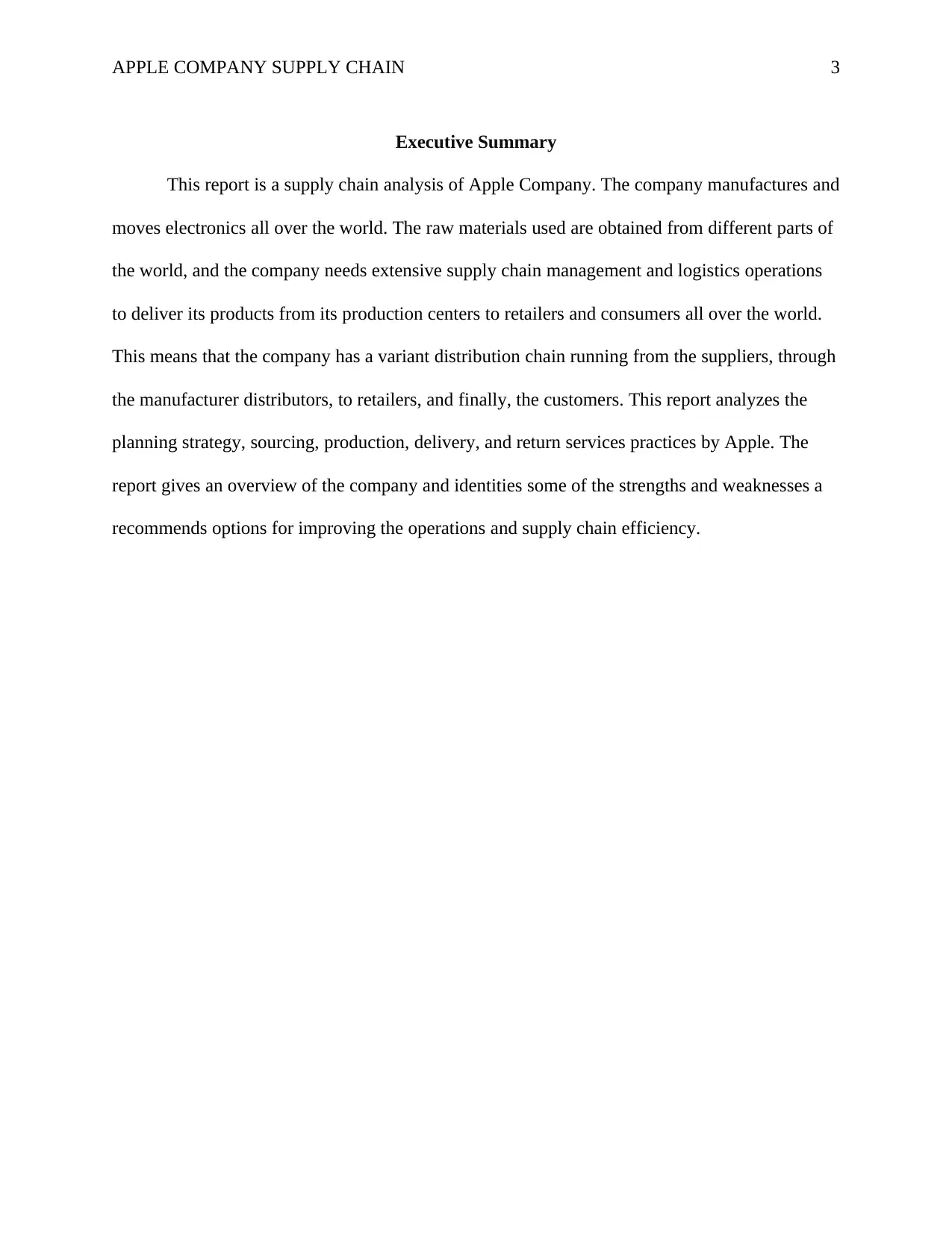
APPLE COMPANY SUPPLY CHAIN 3
Executive Summary
This report is a supply chain analysis of Apple Company. The company manufactures and
moves electronics all over the world. The raw materials used are obtained from different parts of
the world, and the company needs extensive supply chain management and logistics operations
to deliver its products from its production centers to retailers and consumers all over the world.
This means that the company has a variant distribution chain running from the suppliers, through
the manufacturer distributors, to retailers, and finally, the customers. This report analyzes the
planning strategy, sourcing, production, delivery, and return services practices by Apple. The
report gives an overview of the company and identities some of the strengths and weaknesses a
recommends options for improving the operations and supply chain efficiency.
Executive Summary
This report is a supply chain analysis of Apple Company. The company manufactures and
moves electronics all over the world. The raw materials used are obtained from different parts of
the world, and the company needs extensive supply chain management and logistics operations
to deliver its products from its production centers to retailers and consumers all over the world.
This means that the company has a variant distribution chain running from the suppliers, through
the manufacturer distributors, to retailers, and finally, the customers. This report analyzes the
planning strategy, sourcing, production, delivery, and return services practices by Apple. The
report gives an overview of the company and identities some of the strengths and weaknesses a
recommends options for improving the operations and supply chain efficiency.
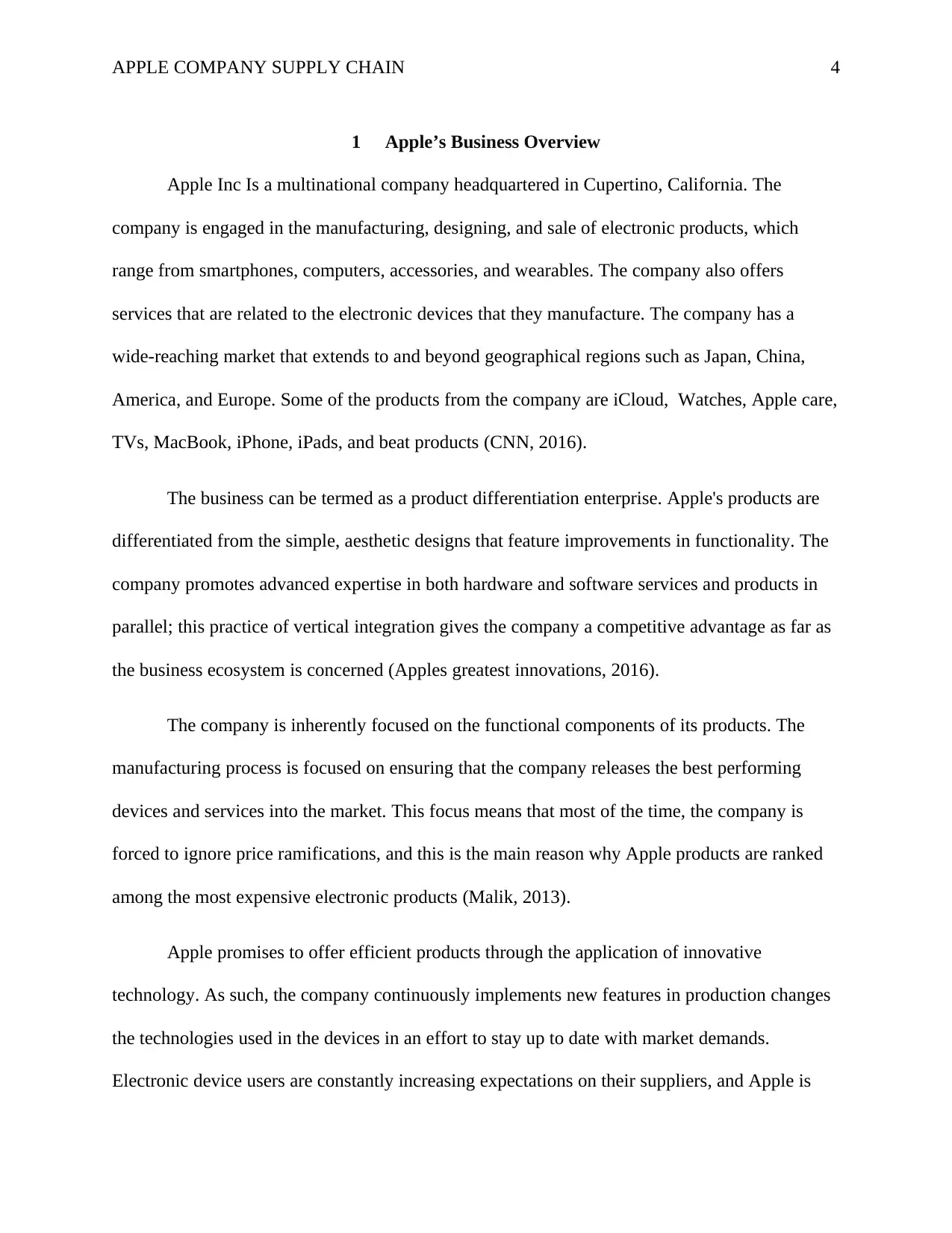
APPLE COMPANY SUPPLY CHAIN 4
1 Apple’s Business Overview
Apple Inc Is a multinational company headquartered in Cupertino, California. The
company is engaged in the manufacturing, designing, and sale of electronic products, which
range from smartphones, computers, accessories, and wearables. The company also offers
services that are related to the electronic devices that they manufacture. The company has a
wide-reaching market that extends to and beyond geographical regions such as Japan, China,
America, and Europe. Some of the products from the company are iCloud, Watches, Apple care,
TVs, MacBook, iPhone, iPads, and beat products (CNN, 2016).
The business can be termed as a product differentiation enterprise. Apple's products are
differentiated from the simple, aesthetic designs that feature improvements in functionality. The
company promotes advanced expertise in both hardware and software services and products in
parallel; this practice of vertical integration gives the company a competitive advantage as far as
the business ecosystem is concerned (Apples greatest innovations, 2016).
The company is inherently focused on the functional components of its products. The
manufacturing process is focused on ensuring that the company releases the best performing
devices and services into the market. This focus means that most of the time, the company is
forced to ignore price ramifications, and this is the main reason why Apple products are ranked
among the most expensive electronic products (Malik, 2013).
Apple promises to offer efficient products through the application of innovative
technology. As such, the company continuously implements new features in production changes
the technologies used in the devices in an effort to stay up to date with market demands.
Electronic device users are constantly increasing expectations on their suppliers, and Apple is
1 Apple’s Business Overview
Apple Inc Is a multinational company headquartered in Cupertino, California. The
company is engaged in the manufacturing, designing, and sale of electronic products, which
range from smartphones, computers, accessories, and wearables. The company also offers
services that are related to the electronic devices that they manufacture. The company has a
wide-reaching market that extends to and beyond geographical regions such as Japan, China,
America, and Europe. Some of the products from the company are iCloud, Watches, Apple care,
TVs, MacBook, iPhone, iPads, and beat products (CNN, 2016).
The business can be termed as a product differentiation enterprise. Apple's products are
differentiated from the simple, aesthetic designs that feature improvements in functionality. The
company promotes advanced expertise in both hardware and software services and products in
parallel; this practice of vertical integration gives the company a competitive advantage as far as
the business ecosystem is concerned (Apples greatest innovations, 2016).
The company is inherently focused on the functional components of its products. The
manufacturing process is focused on ensuring that the company releases the best performing
devices and services into the market. This focus means that most of the time, the company is
forced to ignore price ramifications, and this is the main reason why Apple products are ranked
among the most expensive electronic products (Malik, 2013).
Apple promises to offer efficient products through the application of innovative
technology. As such, the company continuously implements new features in production changes
the technologies used in the devices in an effort to stay up to date with market demands.
Electronic device users are constantly increasing expectations on their suppliers, and Apple is
Secure Best Marks with AI Grader
Need help grading? Try our AI Grader for instant feedback on your assignments.
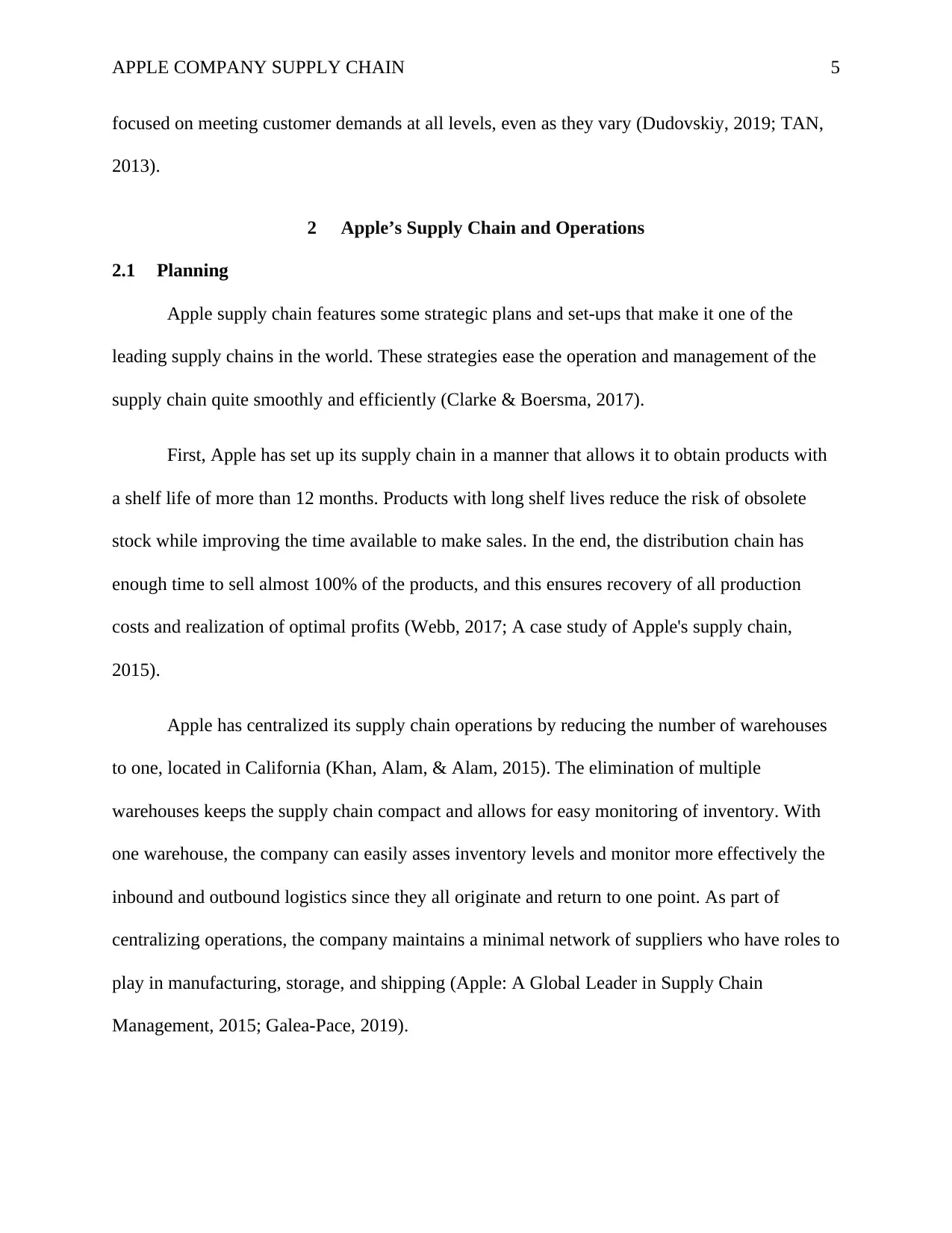
APPLE COMPANY SUPPLY CHAIN 5
focused on meeting customer demands at all levels, even as they vary (Dudovskiy, 2019; TAN,
2013).
2 Apple’s Supply Chain and Operations
2.1 Planning
Apple supply chain features some strategic plans and set-ups that make it one of the
leading supply chains in the world. These strategies ease the operation and management of the
supply chain quite smoothly and efficiently (Clarke & Boersma, 2017).
First, Apple has set up its supply chain in a manner that allows it to obtain products with
a shelf life of more than 12 months. Products with long shelf lives reduce the risk of obsolete
stock while improving the time available to make sales. In the end, the distribution chain has
enough time to sell almost 100% of the products, and this ensures recovery of all production
costs and realization of optimal profits (Webb, 2017; A case study of Apple's supply chain,
2015).
Apple has centralized its supply chain operations by reducing the number of warehouses
to one, located in California (Khan, Alam, & Alam, 2015). The elimination of multiple
warehouses keeps the supply chain compact and allows for easy monitoring of inventory. With
one warehouse, the company can easily asses inventory levels and monitor more effectively the
inbound and outbound logistics since they all originate and return to one point. As part of
centralizing operations, the company maintains a minimal network of suppliers who have roles to
play in manufacturing, storage, and shipping (Apple: A Global Leader in Supply Chain
Management, 2015; Galea-Pace, 2019).
focused on meeting customer demands at all levels, even as they vary (Dudovskiy, 2019; TAN,
2013).
2 Apple’s Supply Chain and Operations
2.1 Planning
Apple supply chain features some strategic plans and set-ups that make it one of the
leading supply chains in the world. These strategies ease the operation and management of the
supply chain quite smoothly and efficiently (Clarke & Boersma, 2017).
First, Apple has set up its supply chain in a manner that allows it to obtain products with
a shelf life of more than 12 months. Products with long shelf lives reduce the risk of obsolete
stock while improving the time available to make sales. In the end, the distribution chain has
enough time to sell almost 100% of the products, and this ensures recovery of all production
costs and realization of optimal profits (Webb, 2017; A case study of Apple's supply chain,
2015).
Apple has centralized its supply chain operations by reducing the number of warehouses
to one, located in California (Khan, Alam, & Alam, 2015). The elimination of multiple
warehouses keeps the supply chain compact and allows for easy monitoring of inventory. With
one warehouse, the company can easily asses inventory levels and monitor more effectively the
inbound and outbound logistics since they all originate and return to one point. As part of
centralizing operations, the company maintains a minimal network of suppliers who have roles to
play in manufacturing, storage, and shipping (Apple: A Global Leader in Supply Chain
Management, 2015; Galea-Pace, 2019).
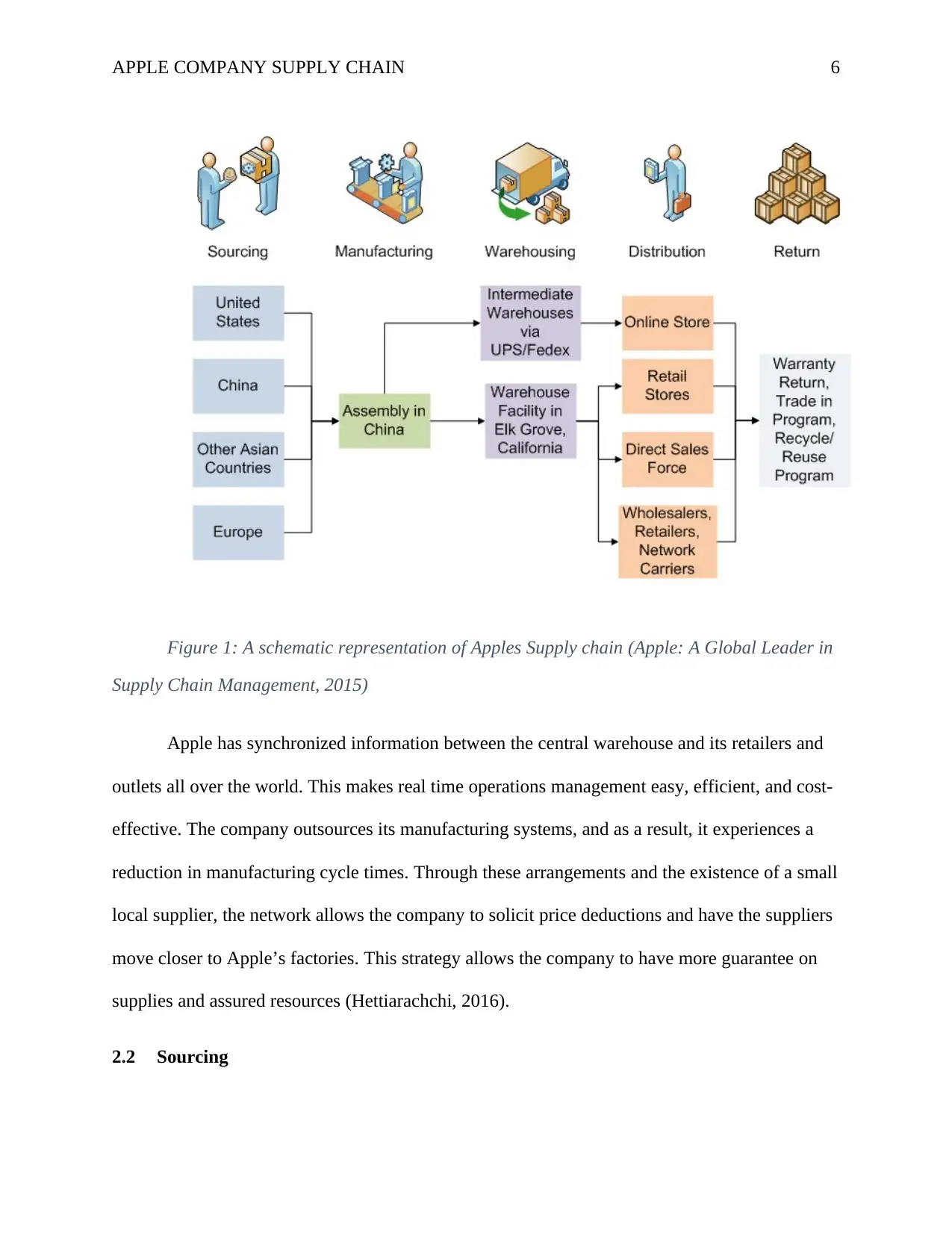
APPLE COMPANY SUPPLY CHAIN 6
Figure 1: A schematic representation of Apples Supply chain (Apple: A Global Leader in
Supply Chain Management, 2015)
Apple has synchronized information between the central warehouse and its retailers and
outlets all over the world. This makes real time operations management easy, efficient, and cost-
effective. The company outsources its manufacturing systems, and as a result, it experiences a
reduction in manufacturing cycle times. Through these arrangements and the existence of a small
local supplier, the network allows the company to solicit price deductions and have the suppliers
move closer to Apple’s factories. This strategy allows the company to have more guarantee on
supplies and assured resources (Hettiarachchi, 2016).
2.2 Sourcing
Figure 1: A schematic representation of Apples Supply chain (Apple: A Global Leader in
Supply Chain Management, 2015)
Apple has synchronized information between the central warehouse and its retailers and
outlets all over the world. This makes real time operations management easy, efficient, and cost-
effective. The company outsources its manufacturing systems, and as a result, it experiences a
reduction in manufacturing cycle times. Through these arrangements and the existence of a small
local supplier, the network allows the company to solicit price deductions and have the suppliers
move closer to Apple’s factories. This strategy allows the company to have more guarantee on
supplies and assured resources (Hettiarachchi, 2016).
2.2 Sourcing
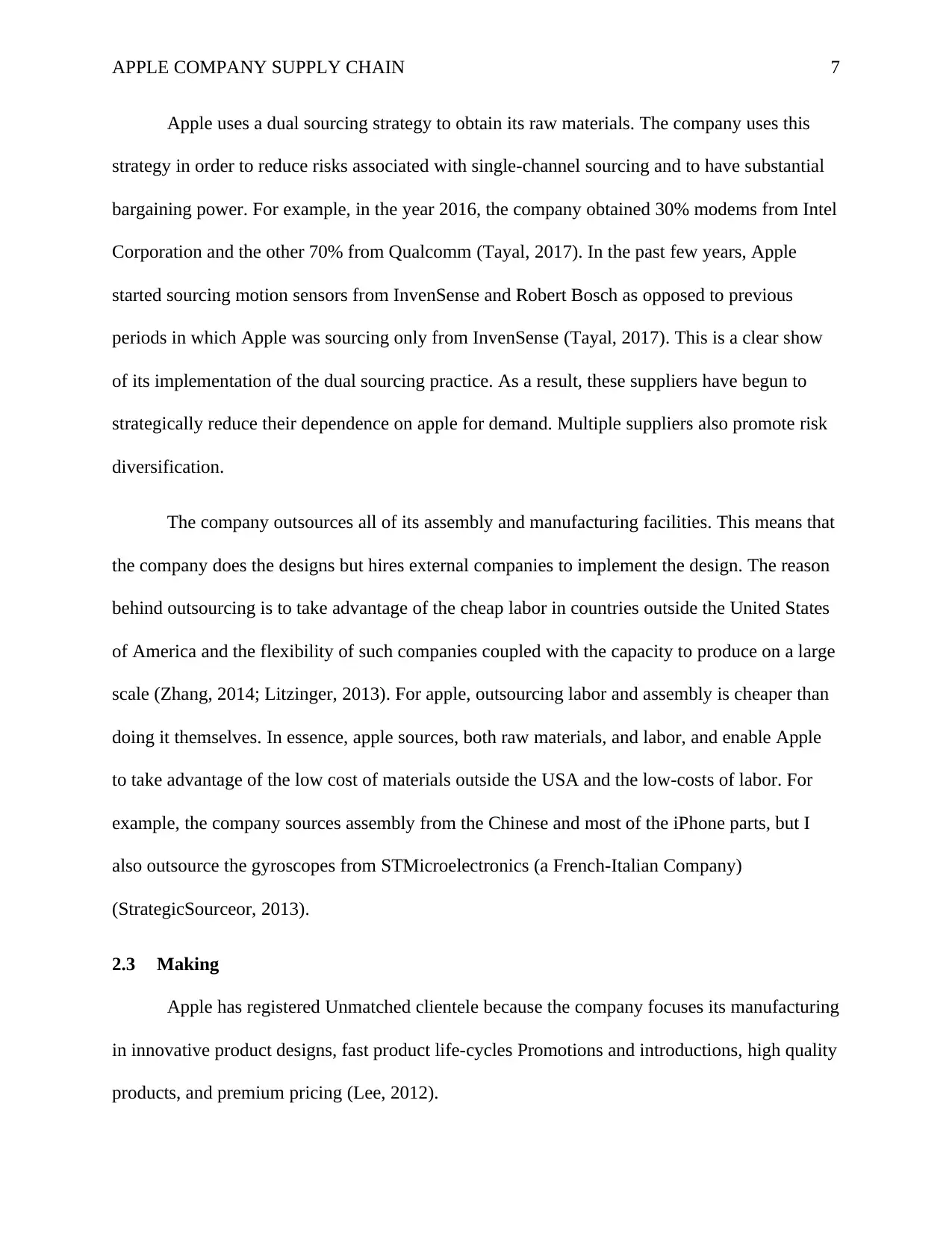
APPLE COMPANY SUPPLY CHAIN 7
Apple uses a dual sourcing strategy to obtain its raw materials. The company uses this
strategy in order to reduce risks associated with single-channel sourcing and to have substantial
bargaining power. For example, in the year 2016, the company obtained 30% modems from Intel
Corporation and the other 70% from Qualcomm (Tayal, 2017). In the past few years, Apple
started sourcing motion sensors from InvenSense and Robert Bosch as opposed to previous
periods in which Apple was sourcing only from InvenSense (Tayal, 2017). This is a clear show
of its implementation of the dual sourcing practice. As a result, these suppliers have begun to
strategically reduce their dependence on apple for demand. Multiple suppliers also promote risk
diversification.
The company outsources all of its assembly and manufacturing facilities. This means that
the company does the designs but hires external companies to implement the design. The reason
behind outsourcing is to take advantage of the cheap labor in countries outside the United States
of America and the flexibility of such companies coupled with the capacity to produce on a large
scale (Zhang, 2014; Litzinger, 2013). For apple, outsourcing labor and assembly is cheaper than
doing it themselves. In essence, apple sources, both raw materials, and labor, and enable Apple
to take advantage of the low cost of materials outside the USA and the low-costs of labor. For
example, the company sources assembly from the Chinese and most of the iPhone parts, but I
also outsource the gyroscopes from STMicroelectronics (a French-Italian Company)
(StrategicSourceor, 2013).
2.3 Making
Apple has registered Unmatched clientele because the company focuses its manufacturing
in innovative product designs, fast product life-cycles Promotions and introductions, high quality
products, and premium pricing (Lee, 2012).
Apple uses a dual sourcing strategy to obtain its raw materials. The company uses this
strategy in order to reduce risks associated with single-channel sourcing and to have substantial
bargaining power. For example, in the year 2016, the company obtained 30% modems from Intel
Corporation and the other 70% from Qualcomm (Tayal, 2017). In the past few years, Apple
started sourcing motion sensors from InvenSense and Robert Bosch as opposed to previous
periods in which Apple was sourcing only from InvenSense (Tayal, 2017). This is a clear show
of its implementation of the dual sourcing practice. As a result, these suppliers have begun to
strategically reduce their dependence on apple for demand. Multiple suppliers also promote risk
diversification.
The company outsources all of its assembly and manufacturing facilities. This means that
the company does the designs but hires external companies to implement the design. The reason
behind outsourcing is to take advantage of the cheap labor in countries outside the United States
of America and the flexibility of such companies coupled with the capacity to produce on a large
scale (Zhang, 2014; Litzinger, 2013). For apple, outsourcing labor and assembly is cheaper than
doing it themselves. In essence, apple sources, both raw materials, and labor, and enable Apple
to take advantage of the low cost of materials outside the USA and the low-costs of labor. For
example, the company sources assembly from the Chinese and most of the iPhone parts, but I
also outsource the gyroscopes from STMicroelectronics (a French-Italian Company)
(StrategicSourceor, 2013).
2.3 Making
Apple has registered Unmatched clientele because the company focuses its manufacturing
in innovative product designs, fast product life-cycles Promotions and introductions, high quality
products, and premium pricing (Lee, 2012).
Paraphrase This Document
Need a fresh take? Get an instant paraphrase of this document with our AI Paraphraser
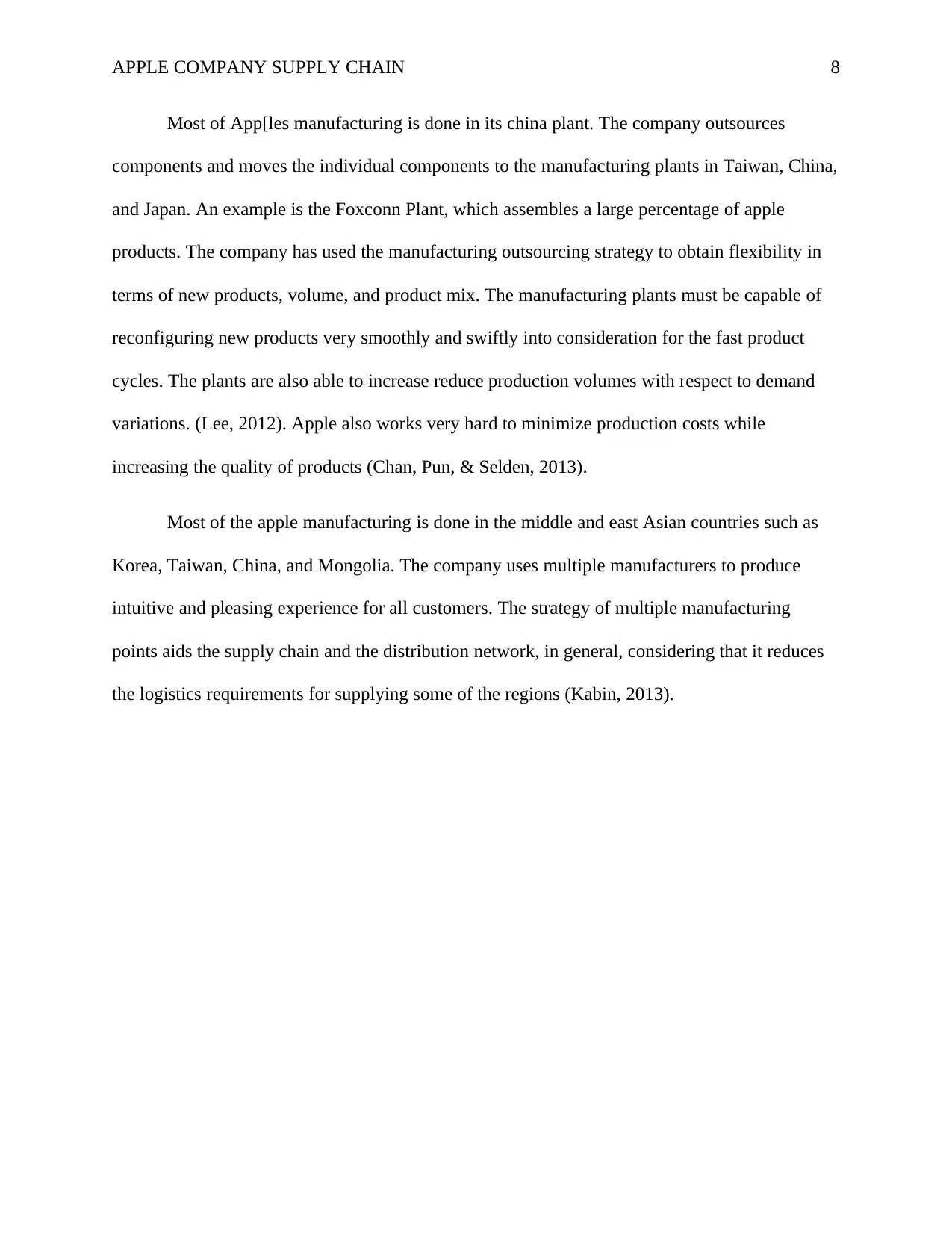
APPLE COMPANY SUPPLY CHAIN 8
Most of App[les manufacturing is done in its china plant. The company outsources
components and moves the individual components to the manufacturing plants in Taiwan, China,
and Japan. An example is the Foxconn Plant, which assembles a large percentage of apple
products. The company has used the manufacturing outsourcing strategy to obtain flexibility in
terms of new products, volume, and product mix. The manufacturing plants must be capable of
reconfiguring new products very smoothly and swiftly into consideration for the fast product
cycles. The plants are also able to increase reduce production volumes with respect to demand
variations. (Lee, 2012). Apple also works very hard to minimize production costs while
increasing the quality of products (Chan, Pun, & Selden, 2013).
Most of the apple manufacturing is done in the middle and east Asian countries such as
Korea, Taiwan, China, and Mongolia. The company uses multiple manufacturers to produce
intuitive and pleasing experience for all customers. The strategy of multiple manufacturing
points aids the supply chain and the distribution network, in general, considering that it reduces
the logistics requirements for supplying some of the regions (Kabin, 2013).
Most of App[les manufacturing is done in its china plant. The company outsources
components and moves the individual components to the manufacturing plants in Taiwan, China,
and Japan. An example is the Foxconn Plant, which assembles a large percentage of apple
products. The company has used the manufacturing outsourcing strategy to obtain flexibility in
terms of new products, volume, and product mix. The manufacturing plants must be capable of
reconfiguring new products very smoothly and swiftly into consideration for the fast product
cycles. The plants are also able to increase reduce production volumes with respect to demand
variations. (Lee, 2012). Apple also works very hard to minimize production costs while
increasing the quality of products (Chan, Pun, & Selden, 2013).
Most of the apple manufacturing is done in the middle and east Asian countries such as
Korea, Taiwan, China, and Mongolia. The company uses multiple manufacturers to produce
intuitive and pleasing experience for all customers. The strategy of multiple manufacturing
points aids the supply chain and the distribution network, in general, considering that it reduces
the logistics requirements for supplying some of the regions (Kabin, 2013).
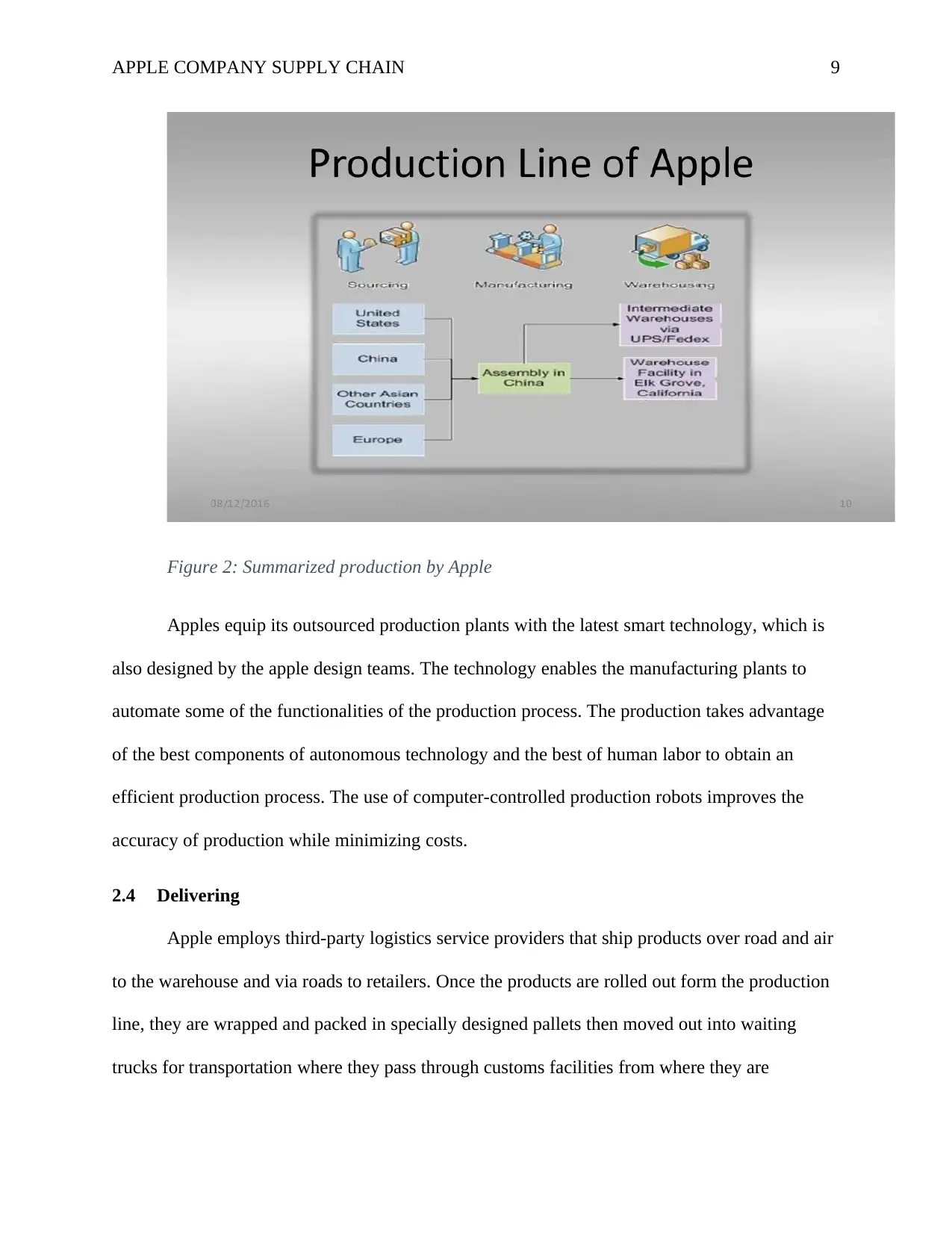
APPLE COMPANY SUPPLY CHAIN 9
Figure 2: Summarized production by Apple
Apples equip its outsourced production plants with the latest smart technology, which is
also designed by the apple design teams. The technology enables the manufacturing plants to
automate some of the functionalities of the production process. The production takes advantage
of the best components of autonomous technology and the best of human labor to obtain an
efficient production process. The use of computer-controlled production robots improves the
accuracy of production while minimizing costs.
2.4 Delivering
Apple employs third-party logistics service providers that ship products over road and air
to the warehouse and via roads to retailers. Once the products are rolled out form the production
line, they are wrapped and packed in specially designed pallets then moved out into waiting
trucks for transportation where they pass through customs facilities from where they are
Figure 2: Summarized production by Apple
Apples equip its outsourced production plants with the latest smart technology, which is
also designed by the apple design teams. The technology enables the manufacturing plants to
automate some of the functionalities of the production process. The production takes advantage
of the best components of autonomous technology and the best of human labor to obtain an
efficient production process. The use of computer-controlled production robots improves the
accuracy of production while minimizing costs.
2.4 Delivering
Apple employs third-party logistics service providers that ship products over road and air
to the warehouse and via roads to retailers. Once the products are rolled out form the production
line, they are wrapped and packed in specially designed pallets then moved out into waiting
trucks for transportation where they pass through customs facilities from where they are
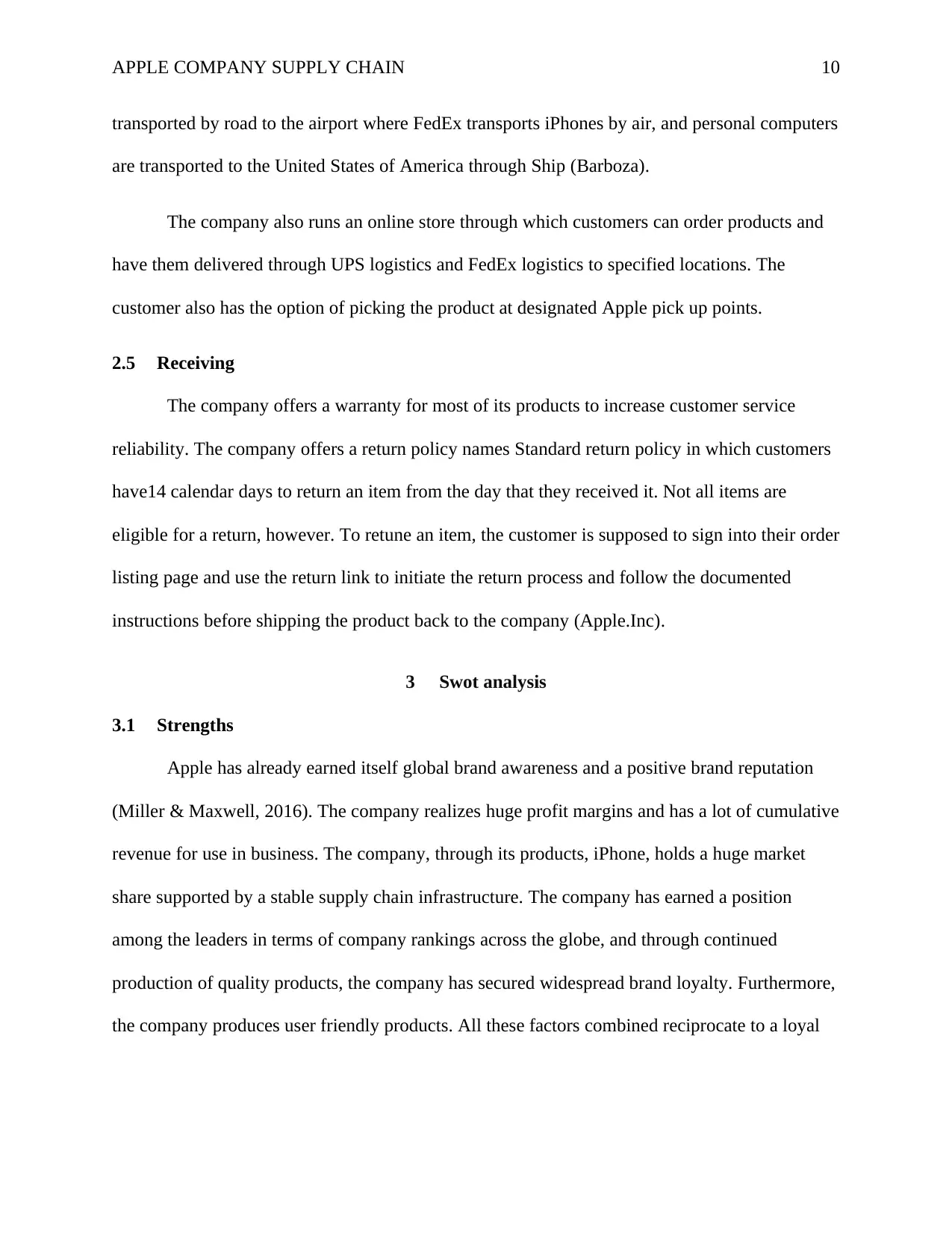
APPLE COMPANY SUPPLY CHAIN 10
transported by road to the airport where FedEx transports iPhones by air, and personal computers
are transported to the United States of America through Ship (Barboza).
The company also runs an online store through which customers can order products and
have them delivered through UPS logistics and FedEx logistics to specified locations. The
customer also has the option of picking the product at designated Apple pick up points.
2.5 Receiving
The company offers a warranty for most of its products to increase customer service
reliability. The company offers a return policy names Standard return policy in which customers
have14 calendar days to return an item from the day that they received it. Not all items are
eligible for a return, however. To retune an item, the customer is supposed to sign into their order
listing page and use the return link to initiate the return process and follow the documented
instructions before shipping the product back to the company (Apple.Inc).
3 Swot analysis
3.1 Strengths
Apple has already earned itself global brand awareness and a positive brand reputation
(Miller & Maxwell, 2016). The company realizes huge profit margins and has a lot of cumulative
revenue for use in business. The company, through its products, iPhone, holds a huge market
share supported by a stable supply chain infrastructure. The company has earned a position
among the leaders in terms of company rankings across the globe, and through continued
production of quality products, the company has secured widespread brand loyalty. Furthermore,
the company produces user friendly products. All these factors combined reciprocate to a loyal
transported by road to the airport where FedEx transports iPhones by air, and personal computers
are transported to the United States of America through Ship (Barboza).
The company also runs an online store through which customers can order products and
have them delivered through UPS logistics and FedEx logistics to specified locations. The
customer also has the option of picking the product at designated Apple pick up points.
2.5 Receiving
The company offers a warranty for most of its products to increase customer service
reliability. The company offers a return policy names Standard return policy in which customers
have14 calendar days to return an item from the day that they received it. Not all items are
eligible for a return, however. To retune an item, the customer is supposed to sign into their order
listing page and use the return link to initiate the return process and follow the documented
instructions before shipping the product back to the company (Apple.Inc).
3 Swot analysis
3.1 Strengths
Apple has already earned itself global brand awareness and a positive brand reputation
(Miller & Maxwell, 2016). The company realizes huge profit margins and has a lot of cumulative
revenue for use in business. The company, through its products, iPhone, holds a huge market
share supported by a stable supply chain infrastructure. The company has earned a position
among the leaders in terms of company rankings across the globe, and through continued
production of quality products, the company has secured widespread brand loyalty. Furthermore,
the company produces user friendly products. All these factors combined reciprocate to a loyal
Secure Best Marks with AI Grader
Need help grading? Try our AI Grader for instant feedback on your assignments.
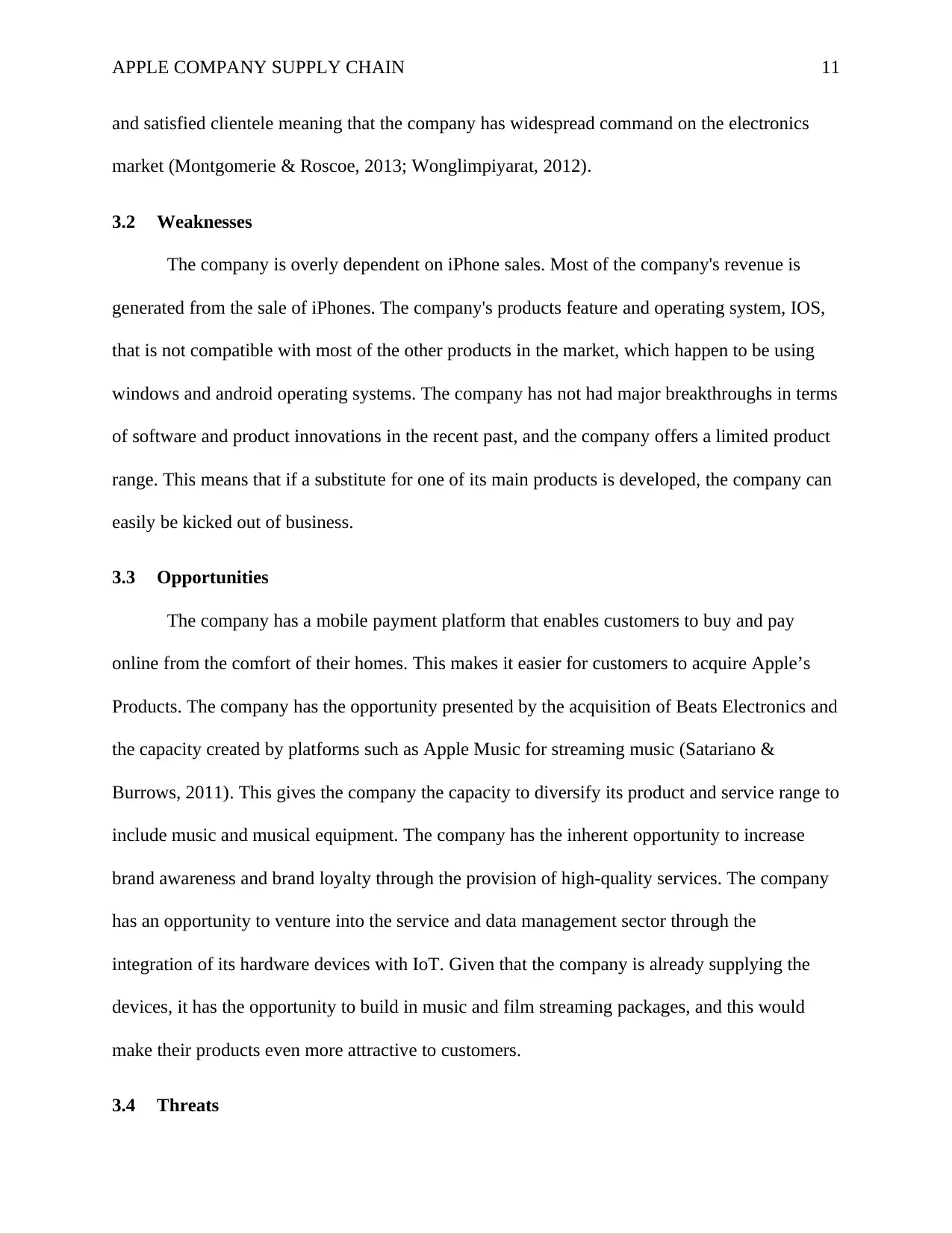
APPLE COMPANY SUPPLY CHAIN 11
and satisfied clientele meaning that the company has widespread command on the electronics
market (Montgomerie & Roscoe, 2013; Wonglimpiyarat, 2012).
3.2 Weaknesses
The company is overly dependent on iPhone sales. Most of the company's revenue is
generated from the sale of iPhones. The company's products feature and operating system, IOS,
that is not compatible with most of the other products in the market, which happen to be using
windows and android operating systems. The company has not had major breakthroughs in terms
of software and product innovations in the recent past, and the company offers a limited product
range. This means that if a substitute for one of its main products is developed, the company can
easily be kicked out of business.
3.3 Opportunities
The company has a mobile payment platform that enables customers to buy and pay
online from the comfort of their homes. This makes it easier for customers to acquire Apple’s
Products. The company has the opportunity presented by the acquisition of Beats Electronics and
the capacity created by platforms such as Apple Music for streaming music (Satariano &
Burrows, 2011). This gives the company the capacity to diversify its product and service range to
include music and musical equipment. The company has the inherent opportunity to increase
brand awareness and brand loyalty through the provision of high-quality services. The company
has an opportunity to venture into the service and data management sector through the
integration of its hardware devices with IoT. Given that the company is already supplying the
devices, it has the opportunity to build in music and film streaming packages, and this would
make their products even more attractive to customers.
3.4 Threats
and satisfied clientele meaning that the company has widespread command on the electronics
market (Montgomerie & Roscoe, 2013; Wonglimpiyarat, 2012).
3.2 Weaknesses
The company is overly dependent on iPhone sales. Most of the company's revenue is
generated from the sale of iPhones. The company's products feature and operating system, IOS,
that is not compatible with most of the other products in the market, which happen to be using
windows and android operating systems. The company has not had major breakthroughs in terms
of software and product innovations in the recent past, and the company offers a limited product
range. This means that if a substitute for one of its main products is developed, the company can
easily be kicked out of business.
3.3 Opportunities
The company has a mobile payment platform that enables customers to buy and pay
online from the comfort of their homes. This makes it easier for customers to acquire Apple’s
Products. The company has the opportunity presented by the acquisition of Beats Electronics and
the capacity created by platforms such as Apple Music for streaming music (Satariano &
Burrows, 2011). This gives the company the capacity to diversify its product and service range to
include music and musical equipment. The company has the inherent opportunity to increase
brand awareness and brand loyalty through the provision of high-quality services. The company
has an opportunity to venture into the service and data management sector through the
integration of its hardware devices with IoT. Given that the company is already supplying the
devices, it has the opportunity to build in music and film streaming packages, and this would
make their products even more attractive to customers.
3.4 Threats
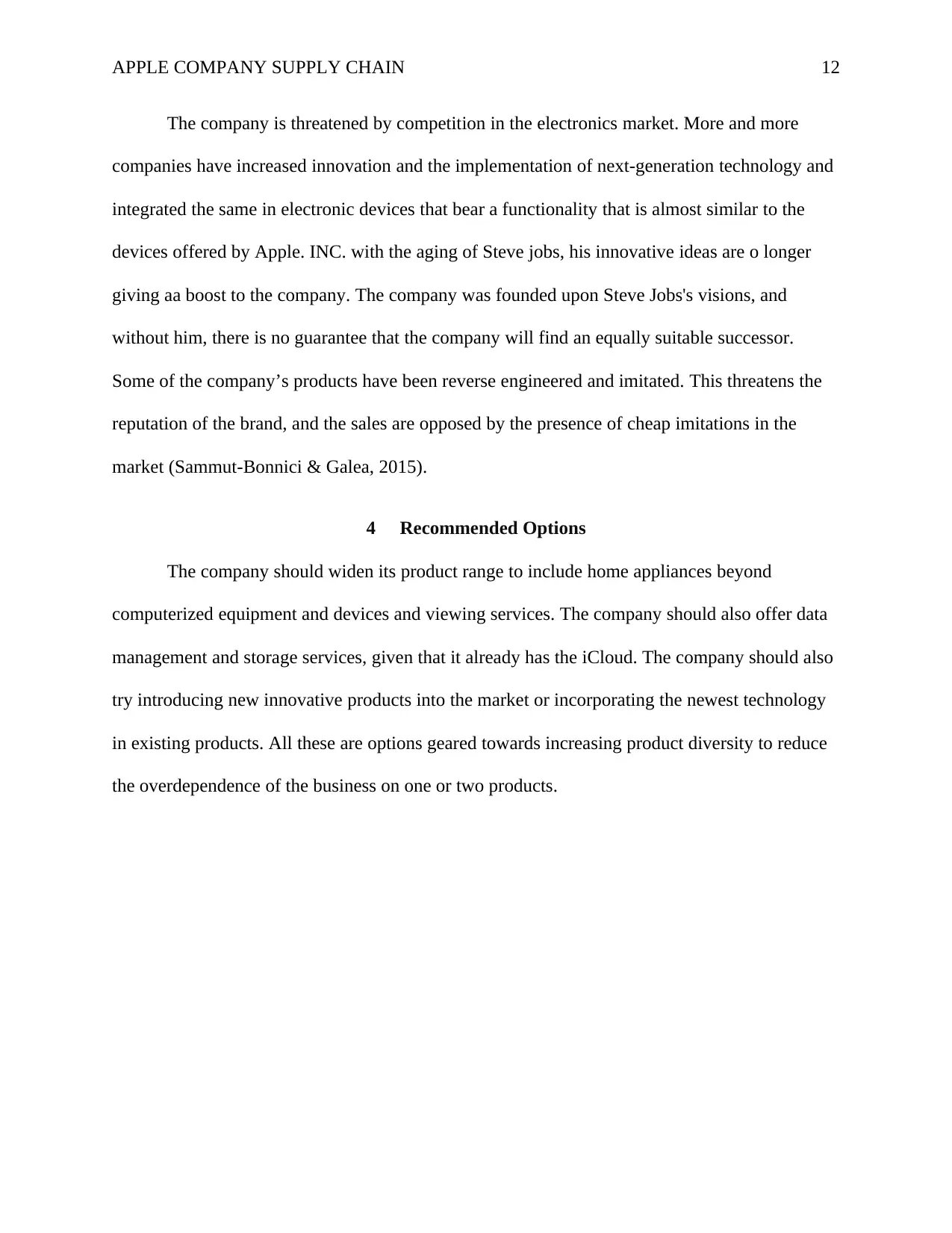
APPLE COMPANY SUPPLY CHAIN 12
The company is threatened by competition in the electronics market. More and more
companies have increased innovation and the implementation of next-generation technology and
integrated the same in electronic devices that bear a functionality that is almost similar to the
devices offered by Apple. INC. with the aging of Steve jobs, his innovative ideas are o longer
giving aa boost to the company. The company was founded upon Steve Jobs's visions, and
without him, there is no guarantee that the company will find an equally suitable successor.
Some of the company’s products have been reverse engineered and imitated. This threatens the
reputation of the brand, and the sales are opposed by the presence of cheap imitations in the
market (Sammut-Bonnici & Galea, 2015).
4 Recommended Options
The company should widen its product range to include home appliances beyond
computerized equipment and devices and viewing services. The company should also offer data
management and storage services, given that it already has the iCloud. The company should also
try introducing new innovative products into the market or incorporating the newest technology
in existing products. All these are options geared towards increasing product diversity to reduce
the overdependence of the business on one or two products.
The company is threatened by competition in the electronics market. More and more
companies have increased innovation and the implementation of next-generation technology and
integrated the same in electronic devices that bear a functionality that is almost similar to the
devices offered by Apple. INC. with the aging of Steve jobs, his innovative ideas are o longer
giving aa boost to the company. The company was founded upon Steve Jobs's visions, and
without him, there is no guarantee that the company will find an equally suitable successor.
Some of the company’s products have been reverse engineered and imitated. This threatens the
reputation of the brand, and the sales are opposed by the presence of cheap imitations in the
market (Sammut-Bonnici & Galea, 2015).
4 Recommended Options
The company should widen its product range to include home appliances beyond
computerized equipment and devices and viewing services. The company should also offer data
management and storage services, given that it already has the iCloud. The company should also
try introducing new innovative products into the market or incorporating the newest technology
in existing products. All these are options geared towards increasing product diversity to reduce
the overdependence of the business on one or two products.
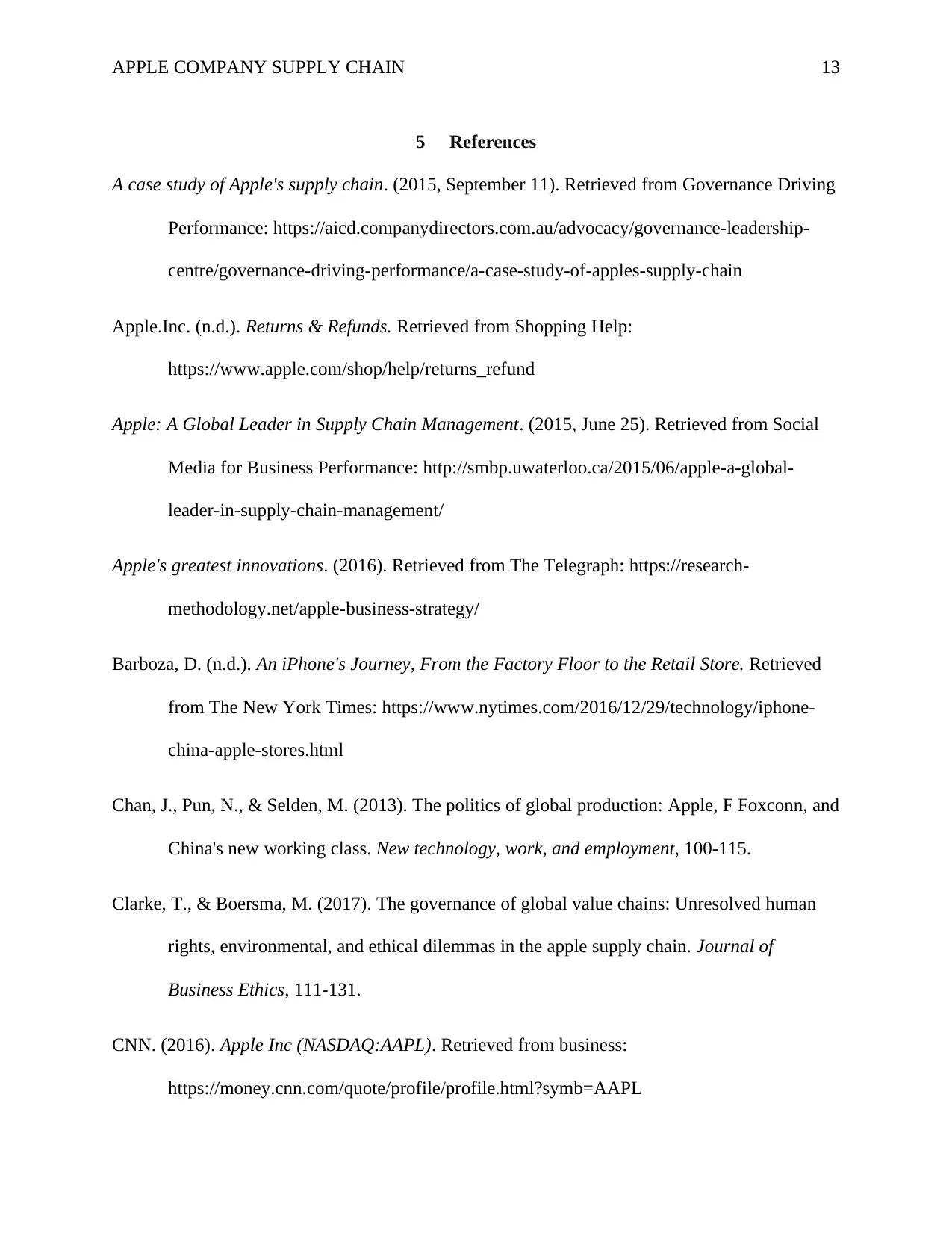
APPLE COMPANY SUPPLY CHAIN 13
5 References
A case study of Apple's supply chain. (2015, September 11). Retrieved from Governance Driving
Performance: https://aicd.companydirectors.com.au/advocacy/governance-leadership-
centre/governance-driving-performance/a-case-study-of-apples-supply-chain
Apple.Inc. (n.d.). Returns & Refunds. Retrieved from Shopping Help:
https://www.apple.com/shop/help/returns_refund
Apple: A Global Leader in Supply Chain Management. (2015, June 25). Retrieved from Social
Media for Business Performance: http://smbp.uwaterloo.ca/2015/06/apple-a-global-
leader-in-supply-chain-management/
Apple's greatest innovations. (2016). Retrieved from The Telegraph: https://research-
methodology.net/apple-business-strategy/
Barboza, D. (n.d.). An iPhone's Journey, From the Factory Floor to the Retail Store. Retrieved
from The New York Times: https://www.nytimes.com/2016/12/29/technology/iphone-
china-apple-stores.html
Chan, J., Pun, N., & Selden, M. (2013). The politics of global production: Apple, F Foxconn, and
China's new working class. New technology, work, and employment, 100-115.
Clarke, T., & Boersma, M. (2017). The governance of global value chains: Unresolved human
rights, environmental, and ethical dilemmas in the apple supply chain. Journal of
Business Ethics, 111-131.
CNN. (2016). Apple Inc (NASDAQ:AAPL). Retrieved from business:
https://money.cnn.com/quote/profile/profile.html?symb=AAPL
5 References
A case study of Apple's supply chain. (2015, September 11). Retrieved from Governance Driving
Performance: https://aicd.companydirectors.com.au/advocacy/governance-leadership-
centre/governance-driving-performance/a-case-study-of-apples-supply-chain
Apple.Inc. (n.d.). Returns & Refunds. Retrieved from Shopping Help:
https://www.apple.com/shop/help/returns_refund
Apple: A Global Leader in Supply Chain Management. (2015, June 25). Retrieved from Social
Media for Business Performance: http://smbp.uwaterloo.ca/2015/06/apple-a-global-
leader-in-supply-chain-management/
Apple's greatest innovations. (2016). Retrieved from The Telegraph: https://research-
methodology.net/apple-business-strategy/
Barboza, D. (n.d.). An iPhone's Journey, From the Factory Floor to the Retail Store. Retrieved
from The New York Times: https://www.nytimes.com/2016/12/29/technology/iphone-
china-apple-stores.html
Chan, J., Pun, N., & Selden, M. (2013). The politics of global production: Apple, F Foxconn, and
China's new working class. New technology, work, and employment, 100-115.
Clarke, T., & Boersma, M. (2017). The governance of global value chains: Unresolved human
rights, environmental, and ethical dilemmas in the apple supply chain. Journal of
Business Ethics, 111-131.
CNN. (2016). Apple Inc (NASDAQ:AAPL). Retrieved from business:
https://money.cnn.com/quote/profile/profile.html?symb=AAPL
Paraphrase This Document
Need a fresh take? Get an instant paraphrase of this document with our AI Paraphraser
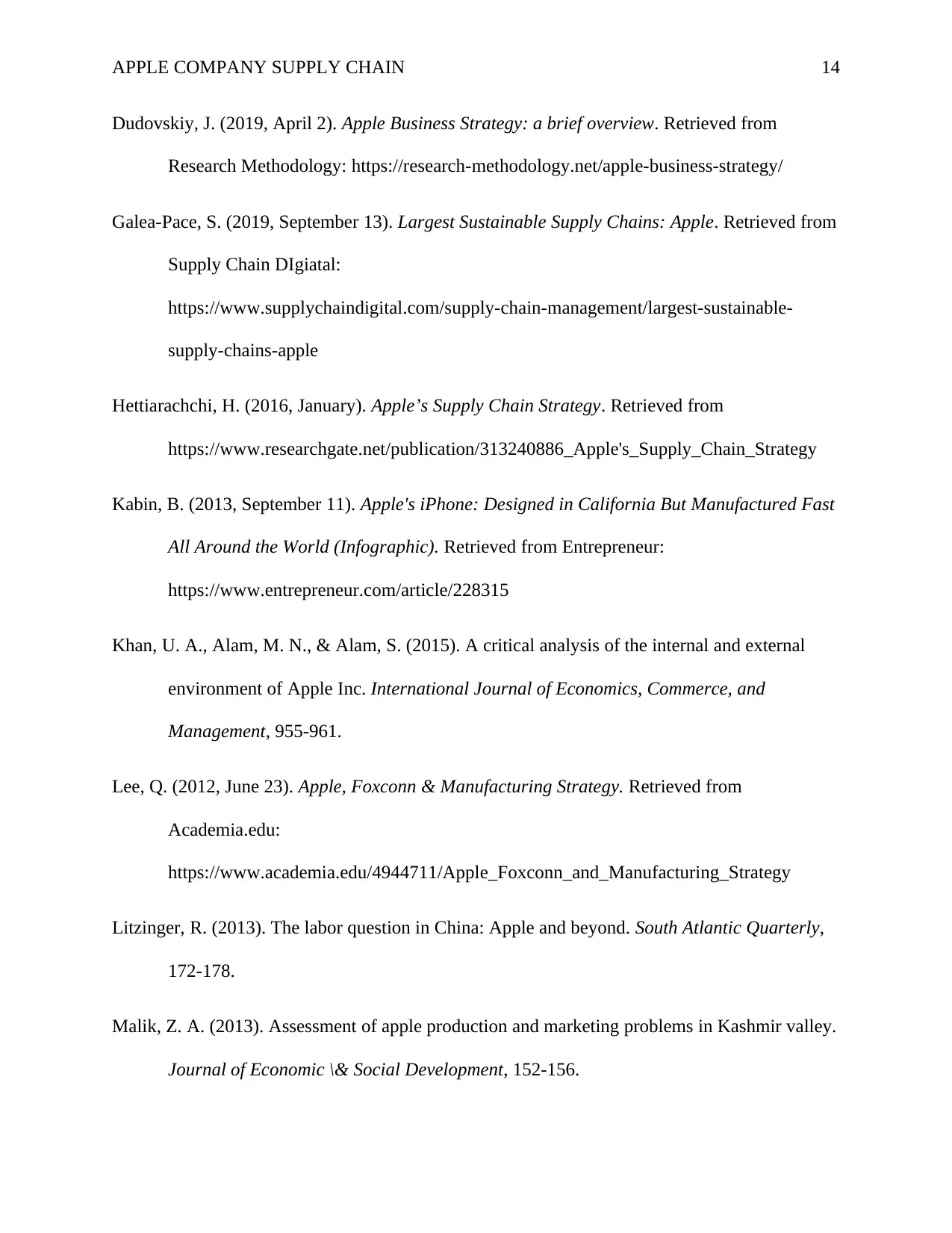
APPLE COMPANY SUPPLY CHAIN 14
Dudovskiy, J. (2019, April 2). Apple Business Strategy: a brief overview. Retrieved from
Research Methodology: https://research-methodology.net/apple-business-strategy/
Galea-Pace, S. (2019, September 13). Largest Sustainable Supply Chains: Apple. Retrieved from
Supply Chain DIgiatal:
https://www.supplychaindigital.com/supply-chain-management/largest-sustainable-
supply-chains-apple
Hettiarachchi, H. (2016, January). Apple’s Supply Chain Strategy. Retrieved from
https://www.researchgate.net/publication/313240886_Apple's_Supply_Chain_Strategy
Kabin, B. (2013, September 11). Apple's iPhone: Designed in California But Manufactured Fast
All Around the World (Infographic). Retrieved from Entrepreneur:
https://www.entrepreneur.com/article/228315
Khan, U. A., Alam, M. N., & Alam, S. (2015). A critical analysis of the internal and external
environment of Apple Inc. International Journal of Economics, Commerce, and
Management, 955-961.
Lee, Q. (2012, June 23). Apple, Foxconn & Manufacturing Strategy. Retrieved from
Academia.edu:
https://www.academia.edu/4944711/Apple_Foxconn_and_Manufacturing_Strategy
Litzinger, R. (2013). The labor question in China: Apple and beyond. South Atlantic Quarterly,
172-178.
Malik, Z. A. (2013). Assessment of apple production and marketing problems in Kashmir valley.
Journal of Economic \& Social Development, 152-156.
Dudovskiy, J. (2019, April 2). Apple Business Strategy: a brief overview. Retrieved from
Research Methodology: https://research-methodology.net/apple-business-strategy/
Galea-Pace, S. (2019, September 13). Largest Sustainable Supply Chains: Apple. Retrieved from
Supply Chain DIgiatal:
https://www.supplychaindigital.com/supply-chain-management/largest-sustainable-
supply-chains-apple
Hettiarachchi, H. (2016, January). Apple’s Supply Chain Strategy. Retrieved from
https://www.researchgate.net/publication/313240886_Apple's_Supply_Chain_Strategy
Kabin, B. (2013, September 11). Apple's iPhone: Designed in California But Manufactured Fast
All Around the World (Infographic). Retrieved from Entrepreneur:
https://www.entrepreneur.com/article/228315
Khan, U. A., Alam, M. N., & Alam, S. (2015). A critical analysis of the internal and external
environment of Apple Inc. International Journal of Economics, Commerce, and
Management, 955-961.
Lee, Q. (2012, June 23). Apple, Foxconn & Manufacturing Strategy. Retrieved from
Academia.edu:
https://www.academia.edu/4944711/Apple_Foxconn_and_Manufacturing_Strategy
Litzinger, R. (2013). The labor question in China: Apple and beyond. South Atlantic Quarterly,
172-178.
Malik, Z. A. (2013). Assessment of apple production and marketing problems in Kashmir valley.
Journal of Economic \& Social Development, 152-156.
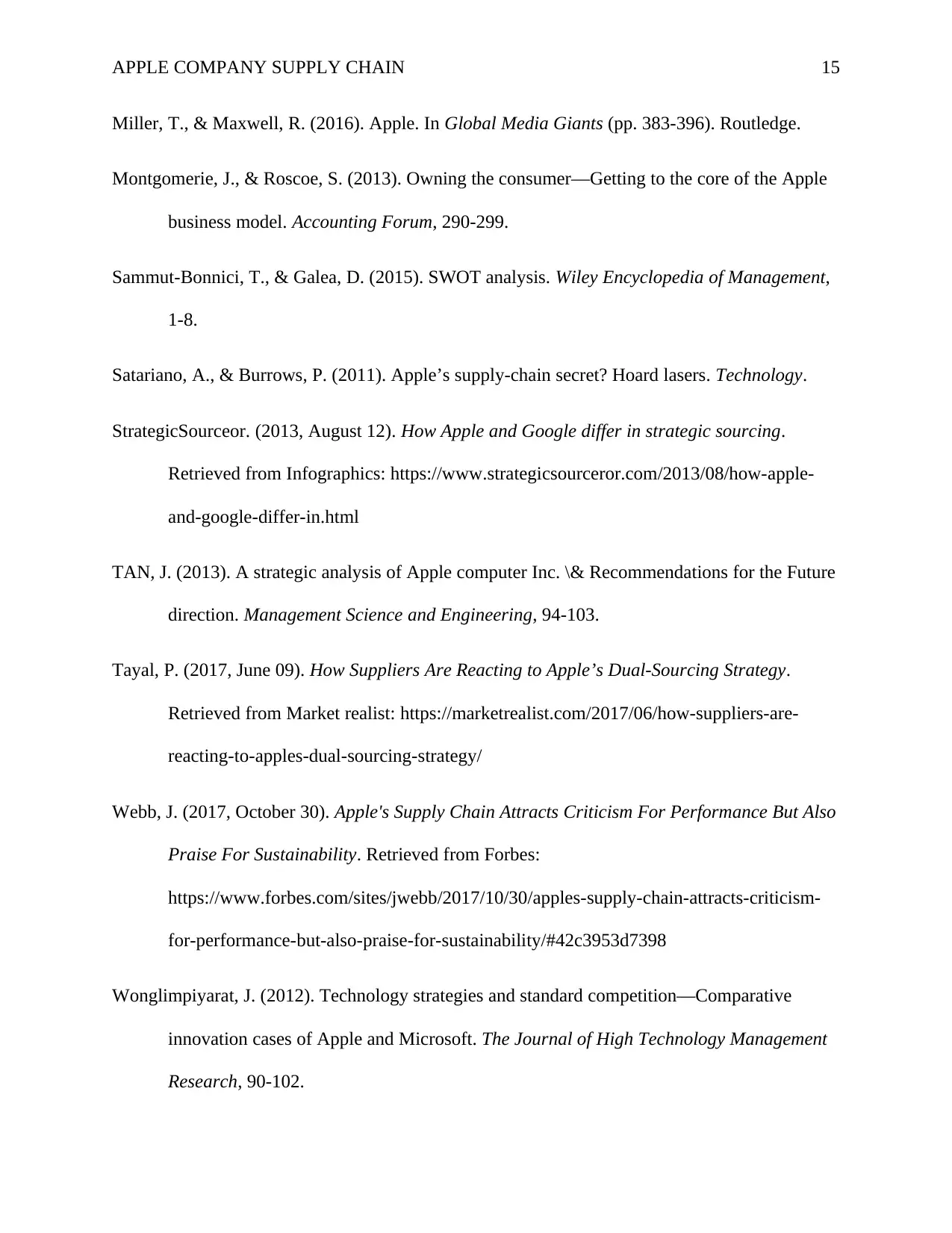
APPLE COMPANY SUPPLY CHAIN 15
Miller, T., & Maxwell, R. (2016). Apple. In Global Media Giants (pp. 383-396). Routledge.
Montgomerie, J., & Roscoe, S. (2013). Owning the consumer—Getting to the core of the Apple
business model. Accounting Forum, 290-299.
Sammut-Bonnici, T., & Galea, D. (2015). SWOT analysis. Wiley Encyclopedia of Management,
1-8.
Satariano, A., & Burrows, P. (2011). Apple’s supply-chain secret? Hoard lasers. Technology.
StrategicSourceor. (2013, August 12). How Apple and Google differ in strategic sourcing.
Retrieved from Infographics: https://www.strategicsourceror.com/2013/08/how-apple-
and-google-differ-in.html
TAN, J. (2013). A strategic analysis of Apple computer Inc. \& Recommendations for the Future
direction. Management Science and Engineering, 94-103.
Tayal, P. (2017, June 09). How Suppliers Are Reacting to Apple’s Dual-Sourcing Strategy.
Retrieved from Market realist: https://marketrealist.com/2017/06/how-suppliers-are-
reacting-to-apples-dual-sourcing-strategy/
Webb, J. (2017, October 30). Apple's Supply Chain Attracts Criticism For Performance But Also
Praise For Sustainability. Retrieved from Forbes:
https://www.forbes.com/sites/jwebb/2017/10/30/apples-supply-chain-attracts-criticism-
for-performance-but-also-praise-for-sustainability/#42c3953d7398
Wonglimpiyarat, J. (2012). Technology strategies and standard competition—Comparative
innovation cases of Apple and Microsoft. The Journal of High Technology Management
Research, 90-102.
Miller, T., & Maxwell, R. (2016). Apple. In Global Media Giants (pp. 383-396). Routledge.
Montgomerie, J., & Roscoe, S. (2013). Owning the consumer—Getting to the core of the Apple
business model. Accounting Forum, 290-299.
Sammut-Bonnici, T., & Galea, D. (2015). SWOT analysis. Wiley Encyclopedia of Management,
1-8.
Satariano, A., & Burrows, P. (2011). Apple’s supply-chain secret? Hoard lasers. Technology.
StrategicSourceor. (2013, August 12). How Apple and Google differ in strategic sourcing.
Retrieved from Infographics: https://www.strategicsourceror.com/2013/08/how-apple-
and-google-differ-in.html
TAN, J. (2013). A strategic analysis of Apple computer Inc. \& Recommendations for the Future
direction. Management Science and Engineering, 94-103.
Tayal, P. (2017, June 09). How Suppliers Are Reacting to Apple’s Dual-Sourcing Strategy.
Retrieved from Market realist: https://marketrealist.com/2017/06/how-suppliers-are-
reacting-to-apples-dual-sourcing-strategy/
Webb, J. (2017, October 30). Apple's Supply Chain Attracts Criticism For Performance But Also
Praise For Sustainability. Retrieved from Forbes:
https://www.forbes.com/sites/jwebb/2017/10/30/apples-supply-chain-attracts-criticism-
for-performance-but-also-praise-for-sustainability/#42c3953d7398
Wonglimpiyarat, J. (2012). Technology strategies and standard competition—Comparative
innovation cases of Apple and Microsoft. The Journal of High Technology Management
Research, 90-102.
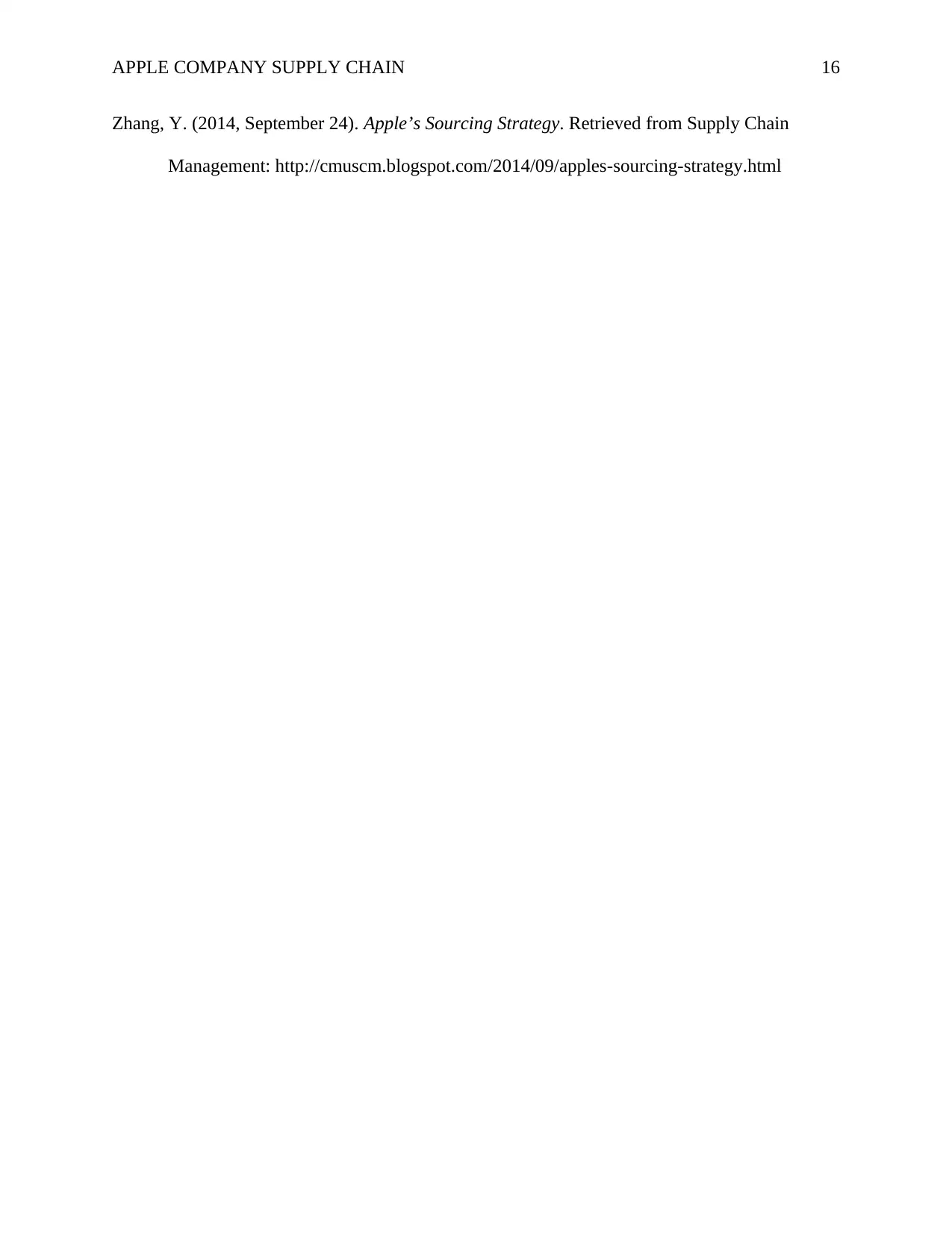
APPLE COMPANY SUPPLY CHAIN 16
Zhang, Y. (2014, September 24). Apple’s Sourcing Strategy. Retrieved from Supply Chain
Management: http://cmuscm.blogspot.com/2014/09/apples-sourcing-strategy.html
Zhang, Y. (2014, September 24). Apple’s Sourcing Strategy. Retrieved from Supply Chain
Management: http://cmuscm.blogspot.com/2014/09/apples-sourcing-strategy.html
1 out of 16
Related Documents
Your All-in-One AI-Powered Toolkit for Academic Success.
+13062052269
info@desklib.com
Available 24*7 on WhatsApp / Email
![[object Object]](/_next/static/media/star-bottom.7253800d.svg)
Unlock your academic potential
© 2024 | Zucol Services PVT LTD | All rights reserved.




